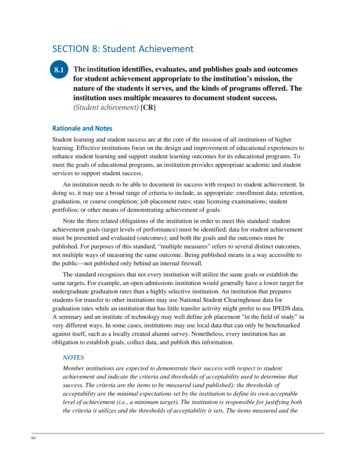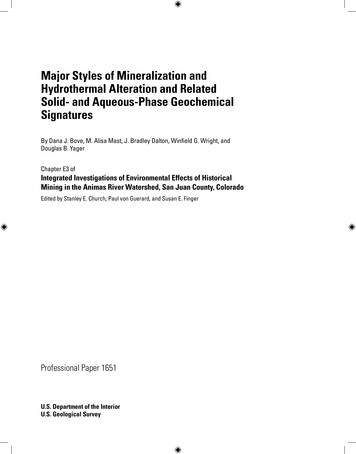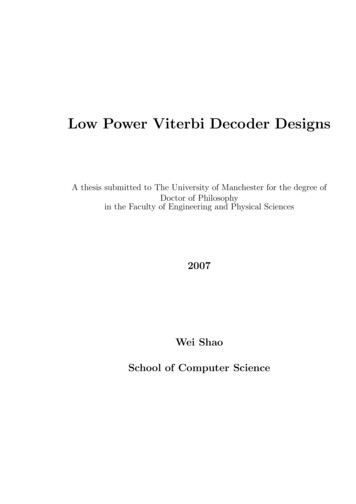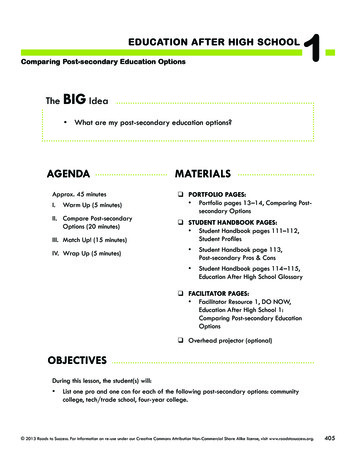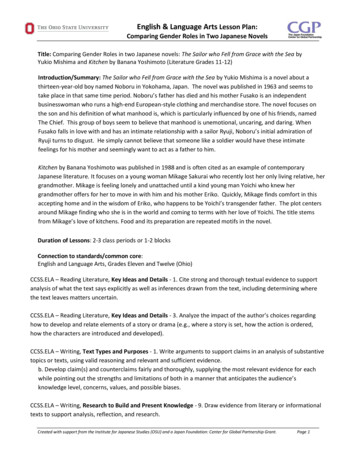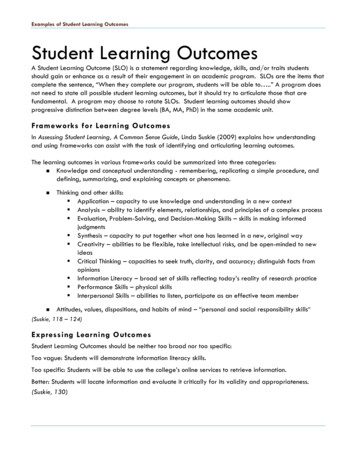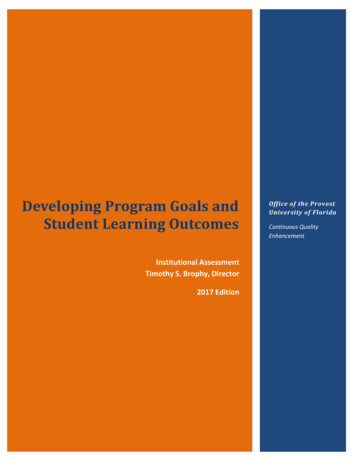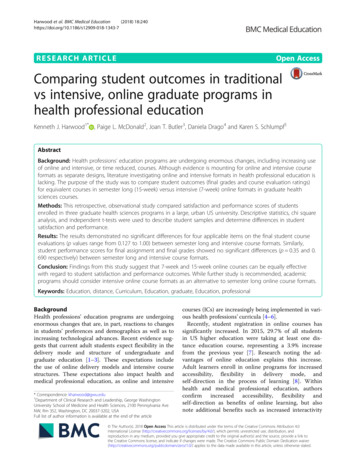
Transcription
Harwood et al. BMC Medical Education(2018) EARCH ARTICLEOpen AccessComparing student outcomes in traditionalvs intensive, online graduate programs inhealth professional educationKenneth J. Harwood1* , Paige L. McDonald2, Joan T. Butler3, Daniela Drago4 and Karen S. Schlumpf5AbstractBackground: Health professions’ education programs are undergoing enormous changes, including increasing useof online and intensive, or time reduced, courses. Although evidence is mounting for online and intensive courseformats as separate designs, literature investigating online and intensive formats in health professional education islacking. The purpose of the study was to compare student outcomes (final grades and course evaluation ratings)for equivalent courses in semester long (15-week) versus intensive (7-week) online formats in graduate healthsciences courses.Methods: This retrospective, observational study compared satisfaction and performance scores of studentsenrolled in three graduate health sciences programs in a large, urban US university. Descriptive statistics, chi squareanalysis, and independent t-tests were used to describe student samples and determine differences in studentsatisfaction and performance.Results: The results demonstrated no significant differences for four applicable items on the final student courseevaluations (p values range from 0.127 to 1.00) between semester long and intensive course formats. Similarly,student performance scores for final assignment and final grades showed no significant differences (p 0.35 and 0.690 respectively) between semester long and intensive course formats.Conclusion: Findings from this study suggest that 7-week and 15-week online courses can be equally effectivewith regard to student satisfaction and performance outcomes. While further study is recommended, academicprograms should consider intensive online course formats as an alternative to semester long online course formats.Keywords: Education, distance, Curriculum, Education, graduate, Education, professionalBackgroundHealth professions’ education programs are undergoingenormous changes that are, in part, reactions to changesin students’ preferences and demographics as well as toincreasing technological advances. Recent evidence suggests that current adult students expect flexibility in thedelivery mode and structure of undergraduate andgraduate education [1–3]. These expectations includethe use of online delivery models and intensive coursestructures. These expectations also impact health andmedical professional education, as online and intensive* Correspondence: kharwood@gwu.edu1Department of Clinical Research and Leadership, George WashingtonUniversity School of Medicine and Health Sciences, 2100 Pennsylvania AveNW, Rm 352, Washington, DC 20037-3202, USAFull list of author information is available at the end of the articlecourses (ICs) are increasingly being implemented in various health professions’ curricula [4–6].Recently, student registration in online courses hassignificantly increased. In 2015, 29.7% of all studentsin US higher education were taking at least one distance education course, representing a 3.9% increasefrom the previous year [7]. Research noting the advantages of online education explains this increase.Adult learners enroll in online programs for increasedaccessibility, flexibility in delivery mode, andself-direction in the process of learning [8]. Withinhealth and medical professional education, authorsconfirm increased accessibility, flexibility andself-direction as benefits of online learning, but alsonote additional benefits such as increased interactivity The Author(s). 2018 Open Access This article is distributed under the terms of the Creative Commons Attribution 4.0International License (http://creativecommons.org/licenses/by/4.0/), which permits unrestricted use, distribution, andreproduction in any medium, provided you give appropriate credit to the original author(s) and the source, provide a link tothe Creative Commons license, and indicate if changes were made. The Creative Commons Public Domain Dedication o/1.0/) applies to the data made available in this article, unless otherwise stated.
Harwood et al. BMC Medical Education(2018) 18:240among participants and improved cost [9–11]. Withregard to learning in health professions and medicaleducation, Cook et al. [12] conducted a systematic review investigating studies on the effects of online instruction and learning compared to studies with noonline component. The authors found a large positiveeffect of online courses compared to no instructionand similar effectiveness compared to more traditionaldelivery methods. Reis et al. [13] investigated 40 medical students who learned urology content in either aface-to-face lecture format or student centered groupdiscussions in a 4-week online course using the Moodle platform (modular object-oriented dynamic learning environment). The results demonstrated that 86%of the students thought the online course was superior to the face-to-face delivery method. Specifically,the online content was better in “encouraging andmotivating learning,” “arousing interest in the topic,”and “fostering teacher and student interactions” (pg.152). Interestingly, the authors found a smaller rangeof grades on the final “increment in learning” assessment for the students in the online format (7.0–9.7)as compared to the face-to-face delivery format (4.0–9.6).In adopting online delivery models, institutions ofhigher education have also been condensing the delivery time of courses, both online and face-to-face. ICshave been increasingly adopted in institutes of highereducation [14–16]. ICs are defined as courses whichdeliver the amount of content typically presented in atraditional 15 or 16-week semester in an intensive(time reduced) period [15, 17–19]. Fanjoy [20] reported that course offerings of online ICs increasedfrom 22 to 36% for 67 public, four-year institutionsbetween 2007 and 2008 for the summer semesters.Like online learning, ICs appeal to the growing number of non-traditional students who have difficultymeeting the demands of courses more traditional inlength or delivery method [8, 14]. These non-traditional students tend to be “slightly older and workingstudents, with slightly higher GPAs than students intraditional courses” ([16], p.1109). Literature suggeststhat non-traditional students prefer ICs due to convenience [14], efficient use of student time [21], andshorter time to completion [22]. In addition, facultyand students think ICs promote a “continuous learning experience” that enables a more intense connection to the content because students focus on fewerclasses at one time [14].Still, higher education research suggests drawbacksto IC course structure and inconclusive evidence regarding overall effectiveness and student satisfaction.ICs require a more concentrated effort in a shorteramount of time, thus reducing the time for studentsPage 2 of 9to review and learn course material and complete assignments [14, 23]. In addition, some researchers suggest this shortened time-frame may be related to theincreases in student reported stress associated to theIC as compared to traditional length courses [14, 15,23, 24]. Further, studies comparing IC to semesterlong courses remains inconclusive. Kucsera andZimmaro [18] report no significant difference in instructor ratings between online ICs and semester longcourses. In reviewing the literature, Hall et al. [16]suggest that a majority of investigations comparingICs to courses of traditional length demonstrate thatICs are associated more with student success; however, a significant proportion of other studies showno difference. Results on students’ satisfaction are alsomixed. Wlodkowski et al. [25] report that students’overall attitudes toward ICs were positive in comparison to semester long courses. Whillier et al. [26] noteequivalent findings regarding student satisfaction;whereas, Mishra et al. [23] find students mostly dissatisfied with ICs. It is important to note an absenceof comparative research on ICs delivered online versus semester long courses delivered online.When considering adoption of ICs in health professions education, Sonnadara and colleagues [27] foundthat a face-to-face IC at the beginning of a first yearorthopedic residency was “highly effective” in teachingtargeted surgical skills. On the other hand, Whillierand Lystad [26] concluded that a cohort of studentswho were involved in a semester long course attainedsignificantly higher final grades compared to a cohorttaught the same content in an IC. Regarding testscores, some evidence reports comparable results between IC and semester long courses [14] and somereport slightly higher results for ICs [28, 29]. Yet,Petrowsky [30] found students in ICs performedworse on comprehensive examinations. However, as ofdate, there is an absence of research comparing online ICs and semester long courses, in either an online or face-to-face delivery model, in healthprofessions education.As online health professional programs considertransitioning from a semester long course model toan IC format, further research is necessary to clarifythe effects of transitioning on student performanceand satisfaction. Hence, the purpose of this paper isto compare student outcomes (performance andsatisfaction) in equivalent, graduate-level, healthscience courses offered in a 7-week intensive (IC) online format and 15-week semester long online format.MethodsStudy aimsThe aims of the study were:
Harwood et al. BMC Medical Education(2018) 18:240(1) To compare student course evaluation scores forequivalent courses in semester long versus intensiveformats in online, graduate level health sciencescourses.(2) To compare student performance scores forequivalent courses in semester long versus intensiveformats in online, graduate level health sciencescourses.Study designThis was a retrospective, observational study. Aconvenience sample was selected from three healthsciences graduate programs at George WashingtonUniversity, School of Medicine and Health Sciences, alarge urban US university. Each program offers an 18credit graduate certificate and a 36 credit Masters ofScience in Health Sciences (MSHS) degree. Table 1describes each program briefly.Each program underwent separate but related processes to condense the 15-week semester long curricula to a 7-week intensive format. The curricularchanges were coordinated among programs through asteering committee; however, individual programmaticchanges were allowed to meet the program’s studentoutcomes and curricular needs. Students were transitioned into the new structure as they entered the program, so they did not select the curriculum format.The semester long and IC versions of the programsused asynchronous teaching methods. The IC courseswere designed to include student cohorts with students taking one course at a time using a rigid sequence of courses and greater use of onlinetechnology, however the 15 week programs allowedstudents to take two courses a semester with greaterflexibility in course sequencing. The detail of the associated changes to pedagogy and curriculum aremore fully described in a companion publication [31].Page 3 of 9The Institutional Review Board approved this study asexempt.Course selectionTo compare the effects of the curricula changes,courses within each program were selected for comparison based on two inclusion criteria. First, thecourse instructor was the same for each version ofthe course (i.e., 7- and 15-weeks). Second, the 7-weekand 15-week versions of each course had the same orsimilar learning objectives, course content, and finalassessment. These criteria were applied to control forpotential differences in faculty instruction and courseassignments. The final assessment in each course wasa written, evidence-based paper. A total of seven pairsof courses were selected for comparison – one pairfrom the clinical research administration (CRA) program, two from health care quality (HCQ), and threefrom regulatory affairs (RAFF). In addition, one healthsciences core (HSCI) course offered in all three programs was included in the analysis. Health sciencescourses are foundational graduate courses that areshared among programs (i.e. biostatistics, epidemiology, leadership).SubjectsThe sample included graduate or graduate certificatestudent records in three programs of study, clinical research administration (CRA), health care quality (HCQ),and regulatory affairs (RAFF). As is typical with theseprograms, a majority of students were adults who maintained full or part time employment in health care or related fields during matriculation.AssessmentsThe courses were compared on measures of studentsatisfaction and student performance. Student satisfaction was assessed using scores from courseTable 1 Health Sciences Graduate Program DescriptionsProgramProgram DescriptionClinical ResearchAdministrationThe Clinical Research Administration program prepares health sciences professionals to participate in the science andbusiness of developing new therapeutics for improving patient care. The rigorous curriculum focuses on regulatoryrequirements, ethical issues, processes for product development, the business of clinical research, and scientific methodprocesses for product development.Health Care QualityThe Health Care Quality program incorporates an interdisciplinary, practice-based curriculum to prepare individuals withhealthcare experience for leadership roles in quality-based healthcare. Graduates of this program gain the knowledge andskills necessary to redefine quality care, including healthcare leadership and organizational change theories and principles,collaboration and safe practices within healthcare teams, risk assessment in patient safety systems, navigating environmentalchanges affecting the healthcare enterprise, and health policy development, implementation and measurement.Regulatory AffairsDeveloped in collaboration with regulatory affairs professionals in governmental agencies, including the Food and DrugAdministration (FDA) and the National Institutes for Health (NIH), the Regulatory Affairs program integrates global regulatorystrategy across the curriculum to equip graduates as business leaders in regulatory strategy locally and abroad. The programcontent focuses on clinical research, product testing, global health, and public health policy.
Harwood et al. BMC Medical Education(2018) 18:240evaluations completed through a voluntary, onlineuniversity system at end of the class. Student satisfaction assessment was based on four items from theuniversity-developed standardized course evaluationform, including: (1) “overall rating of the course,” (2)“how much they learned in the course,” (3) “intellectual challenge,” and (4) “overall instructor rating.”Each item was rated on a 5-point Likert scale. Student performance in the course was assessed in twoways: (1) the final assignment, which in most caseswas a summative, evidence-based paper; and (2) thecourse final grade. Letter grades were reported as theequivalent mean numerical percentage (e.g., an Awas reported as 91.5%).Data analysisStudent satisfaction and student performance datafrom each course were de-identified and coded byprogram administrative staff and provided to the researchers. Administrative staff also provided additionalde-identified student data regarding age, program ofstudy, credit hours completed, and cumulative GPA.All data analyses including sample summary andcomparative statistics were performed using SAS (version 9.3, SAS Institute Inc., Cary NC, USA) and SPSS(version 24, IBM Corp., Armonk, N.Y., USA).Descriptive statistics were generated to describe thestudy population, student satisfaction scores, andcourse grades. Chi-square analyses were conducted toPage 4 of 9compare student satisfaction scores between 7-weekintensive and 15-week semester long courses. Ratingswere dichotomized to “High” or very favourable (4 or5) and “Low” or less favourable (1–3) for comparisonpurposes. To determine differences in the final assignment and final course grades between the two courseformats, independent t-tests were run. All inferentialstatistics were conducted first for an overall comparison between 7-week and 15-week formats for allcourses in total and second for a comparison bycourse.ResultsThe study assessed 245 health sciences student recordsof which 35.1% were enrolled in the clinical research administration program (CRA), 42.9% were enrolled in thehealth care quality program (HCQ), and 22.0% were enrolled in the regulatory affairs program (RAFF). Thestudy population’s mean total credit hours completedwas 28.3 (range: 3–60) credits indicating that most werenearing the end of the programs of study. The mean cumulative GPA of the study population was 3.57 (range:0–4.00).Approximately 44% of the students in this studywere between 31 to 40 years of age. Figure 1 showsthe distribution of age categories for the total studypopulation by program. Most students enrolled in theCRA program are between 26 and 40 years of age(62.6%). Within the HCQ program, 27.8% of theFig. 1 Bar graph of percent (%) of students’ shown by age category (years) for the programs
Harwood et al. BMC Medical Education(2018) 18:240Page 5 of 9students are between the ages of 31 and 35 with asecond peak of 16.7% of the students between theages of 51 and 55. Almost 40% of RAFF students arebetween 31 to 35 years of age.Table 3 Independent t-Test results for student performanceFinal AssignmentStudent satisfactionFinal GradeNinety-nine students in ICs and seventy-seven studentsin 15-week format completed the end of course evaluations. It is important to note that the course evaluationsare voluntary, so the total numbers of students’ responses will vary depending upon the courses, the survey question, and student interest. The courseevaluation response rate varied between 20 and 100% ofeligible respondents over all courses (Appendix). In theoverall comparison of student satisfaction, results fromthe chi-square analysis indicated no significant differences in ratings between 7-week and 15-week formatsfor all four items in the course evaluations (Table 2).Comparisons by each course yield similar findings except for the Health Care Quality Course #2 (Appendix).Students in the intensive 7-week curricula reported significantly lower satisfaction course evaluation ratings(i.e. 1–3) for both intellectual challenge (p 0.033) andinstructor rating (p 0.026).Student performanceA total of 245 student grades (final grade assignmentand final grade) were analyzed from the three programsin both the 15-week and 7-week versions of the courses,including 136 enrolled in the ICs and 109 in the semester long courses. Results of the overall comparisons instudent performance measures indicate no significantdifferences between intensive and semester long courseformats (Table 3). In addition, no significant differenceswere found between IC and semester format in finalgrade and final assignment for each course (Table 4 &Table 5). Differences in mean final assignment andcourse grades were small.DiscussionWhile previous studies have compared the effectivenessof semester long courses and ICs delivered inP-valueNMean (SD)IntensiveTraditional13610991.5 (7.6)89.8 (17.4)0.353IntensiveTraditional13610991.1 (5.8)91.5 (9.3)0.690face-to-face contexts with inconclusive results, this studyis unique in that it considered the effectiveness of15-week and 7-week format for online courses. Whilethe results of prior research related to student satisfaction with face-to-face ICs and face-to-face semester longcourses were mixed [1–4] this study indicates no significant difference in student satisfaction between ICs andsemester long courses delivered online. This researchconfirms the Kucsera and Zimmaro [18] findings of nosignificant difference in instructor ratings and the Whillier and Lystad [26] findings of no significant differencein overall student satisfaction. As higher education andhealth professions’ education seek to identify learningmodels which meet the needs of a wider range of students, including non-traditional, working adult learners,the findings support that adoption of IC models for online courses as a viable choice.The results of the study confirm previous findingswhere no significant difference in student success wasfound between ICs and semester long courses [6] anddisconfirms Whillier and Lystad’s [26]) findings that semester long course formats yield higher student success.As noted in our companion paper [31], our teamadopted a very structured process for curriculumre-design when transitioning from a semester long to ICTable 4 Final assignment grade comparison 7-week versus 15week (by course)Course Structure NCRA Course 1Intensive35 86.2 (8.3)Traditional21 86.4 (12.6)HCQ Course 1 IntensiveTraditionalHCQ Course 2 IntensiveTable 2 Chi-Square results for student course evaluation ratingsP-valueRatingLow n (%) High n (0%)Overall Course RatingIntensive14 (15.6)Traditional 11 (15.5)76 (84.4)60 (84.5)1.000How Much LearnedIntensive11 (11.1)Traditional 6 (8.5)88 (88.9)65 (91.5)0.615Intellectual ChallengeIntensive18 (18.9)Traditional 7 (9.9)77 (81.1)64 (90.1)0.127Overall Instructor Rating Intensive12 (12.4)Traditional 4 (5.6)85 (87.6)67 (94.4)0.186Mean (SD) t-score dfTraditionalRAFF Course 1 IntensiveTraditionalRAFF Course 2 IntensiveTraditionalRAFF Course 3 IntensiveTraditionalHSCI Course 1 IntensiveTraditional12 96.2 (5.8)P-value 0.084 540.9340.953 430.346 0.798 580.4280.895 130.3870.365 190.7190.9084.10.4141.281 13.70.22133 91.2 (17.9)37 94.6 (6.8)23 96.0 (6.5)888.9 (4.8)777.8 (34.8)13 92.8 (4.7)892.1 (4.9)10 83.5 (4.7)568.0 (38.0)21 96.0 (1.5)12 94.8 (3.3)
Harwood et al. BMC Medical Education(2018) 18:240Page 6 of 9Table 5 Final course grade comparison 7-week versus 15-week(by course)Course Structure NCRA Course 1Mean (SD) t-score dfIntensive35 87.7 (5.3)Traditional21 87.7 (12.1)HCQ Course 1 IntensiveTraditionalHCQ Course 2 IntensiveTraditionalRAFF Course 1 IntensiveTraditionalRAFF Course 2 IntensiveTraditionalRAFF Course 3 IntensiveTraditionalHSCI Course 1 IntensiveTraditional12 94.5 (3.9)P-value 0.005 24.70.9960.340 430.736 0.807 580.4230.770 130.455 0.710 190.48633 93.6 (8.0)37 92.5 (5.1)23 93.5 (4.4)889.9 (5.2)785.6 (14.8)13 90.6 (3.5)891.8 (4.4)10 84.6 (4.0)50.2664.20.80382.6 (16.2)21 96.3 (1.1)1.456 140.16712 95.3 (2.3)delivery model. This process and our correspondingfocus on the alignment between course objectives andcourse assignments may help explain these findings. Thecontrolled sequencing of courses in the IC format, whichallowed for scaffolding of knowledge across courses, mayalso help explain these findings. For other programs ofstudy seeking to re-design programs to optimize spaceand time in learning delivery, these results suggest thatonline ICs can be a comparable choice to 15-week extended models of delivery, particularly if emphasis inre-design is placed upon re-alignment of content tocourse objectives, rather than to merely condensingexisting content, and sequencing courses to scaffoldknowledge essential to achieving program competencies.While the findings indicate no significant differencein student performance and satisfaction, it is important to consider the limitations of this study and whatthey suggest for future research. Regarding sampling,the selection of a convenience sample from threehealth sciences graduate programs may introduceselection bias. Regarding student satisfaction, weidentified four items from the end of course evaluations to characterize “satisfaction” (i.e., overall courserating, how much learned, intellectual challenge, andinstructor rating). However, definitions for these itemsare not provided on the evaluations; therefore, itcannot be assumed that all students interpreted themeaning of these items in the same way. In addition,course evaluations – particularly for courses with lowresponse rates – may not present an accurate assessment of the quality of a course, especially as resultsmay be skewed by a respondent who has an axe togrind.Other potential limitations relate to the comparisonof final assignment grades and final course grades.Final qualitative paper grades were used within thisstudy rather than didactic tests. These types of assessments (papers) were thought to align more readilywith determining achievement of course objectives;however, they are less reliable than didactic tests because they may introduce bias in grading. In addition,it is possible that there was a ceiling effect as therange of the final grades and assignments were in the“A” to “A-”range. To counteract some of the bias, rubrics for grading final assignments were used. Also,bias was mitigated by comparing courses taught bythe same instructors. With regard to final coursegrades, grades assigned by instructors within eachcourse varied between letter and numerical grades.Although we applied a mean numerical value to represent letter grades, our estimates of the differencesin final assignment and course grades may not detectsmall variations in grades.ConclusionsFindings from this study suggest that 7-week and15-week online courses can be equally effective withregard to student satisfaction and performanceoutcomes. However, additional research is required ashealth professions education and higher education,wrestle with selecting delivery models that align bothwith the needs of the learner and with the needs ofthe faculty and institutions. In particular, additionalresearch is needed on the faculty experience of teaching 7-week versus 15-week courses, particularly inonline contexts. Variables to consider in this researchare the number of courses faculty have previouslytaught in each delivery model and how this numbermight influence their experience in teaching. Also,faculty workload in facilitation in different deliverymodels should be considered. For future comparativeeducational effectiveness studies on online models ofdelivery, research must also consider faculty experience in online facilitation and how it might influencecourse evaluations, facilitation style, and grades.Finally, additional longitudinal research is requiredto determine the long term effects of different delivery models on overall performance, satisfaction (bothstudent and faculty), and retention of knowledge overtime. Future research might also consider differentmethodological approaches, such as mixed methods,by which to assess the comparative quality of coursesdelivered in different models. With regard to onlineICs, longitudinal research across different programs ofstudy would allow greater understanding of the variables that influence facilitation and learning acrossdifferent course content.
(2018) 18:240Harwood et al. BMC Medical EducationPage 7 of 9AppendixStudent Course Evaluation Ratings by CourseTable 6 Chi-square results for evaluation item on “Overall course rating” (by ate (%)RatingLow n (%)High n (%)CRA Course 1AcceleratedTraditional4523381684.469.62 (5.3)2 (12.5)36 (94.7)14 (87.5)0.573HCQ Course 1AcceleratedTraditional12126650.050.03 (50.0)4 (66.7)3 (50.0)2 (33.3)1.000HCQ Course 2AcceleratedTraditional3844232960.565.96 (26.1)2 (6.9)17 (73.9)27 (93.1)0.118RAFF Course 1AcceleratedTraditional9796100.085.71 (11.1)0 (0.0)8 (88.9)6 (100.0)1.000RAFF Course 3AcceleratedTraditional1054140.020.02 (50.0)1 (100.0)2 (50.0)0 (0.0)1.000HSCI Course 1AcceleratedTraditional211310747.653.80 (0.0)1 (14.3)10 (100.0)6 (85.7)0.412Table 7 Chi-square results for evaluation item on “How much learned” (by lueRatingLow n (%)High n (%)CRA Course 1AcceleratedTraditional4523381684.469.62 (5.3)1 (6.3)36 (94.7)15 (93.8)1.000HCQ Course 1AcceleratedTraditional12126650.050.03 (50.0)2 (33.3)3 (50.0)4 (66.7)1.000HCQ Course 2AcceleratedTraditional3844232960.565.93 (13.0)0 (0.0)20 (87.0)29 (100.0)0.080RAFF Course 1AcceleratedTraditional9796100.085.71 (11.1)0 (0.0)8 (88.9)6 (100.0)1.000RAFF Course 3AcceleratedTraditional1055150.020.00 (0.0)1 (100.0)5 (100.0)0 (0.0)0.167HSCI Course 1AcceleratedTraditional211318785.753.82 (11.1)1 (14.3)16 (88.9)6 (85.7)1.000Table 8 Chi-square results for evaluation item on “Intellectual challenge” (by ngP-valueLow n (%)High n (%)CRA Course 1AcceleratedTraditional4523341675.669.65 (14.7)1 (6.3)29 (85.3)15 (93.8)0.650HCQ Course 1AcceleratedTraditional12126650.050.03 (50.0)3 (50.0)3 (50.0)3 (50.0)1.000HCQ Course 2AcceleratedTraditional3844232960.565.94 (17.4)0 (0.0)19 (82.6)29 (100.0)0.033RAFF Course 1AcceleratedTraditional9796100.085.72 (22.2)0 (0.0)7 (77.8)6 (100.0)0.486RAFF Course 3AcceleratedTraditional1055150.020.01 (20.0)1 (100.0)4 (80.0)0 (0.0)0.333HSCI Course 1AcceleratedTraditional211318785.753.83 (16.7)1 (14.3)15 (83.3)6 (85.7)1.000
(2018) 18:240Harwood et al. BMC Medical EducationPage 8 of 9Table 9 Chi-square results for evaluation item on “Overall instructor rating” (by ateRatingLow n (%)High n (%)CRA Course 1AcceleratedTraditional4523381684.469.61 (2.6)0 (0.0)37 (97.4)16 (100.0)1.000HCQ Course 1AcceleratedTraditional12126650.050.03 (50.0)2 (33.3)3 (50.0)4 (66.7)1.000HCQ Course 2AcceleratedTraditional3844212955.365.94 (19.0)0 (0.0)17 (81.0)29 (100.0)0.026RAFF Course 1AcceleratedTraditional9796100.085.70 (0.0)0 (0.0)9 (100.0)6 (100.0)NARAFF Course 3AcceleratedTraditional1056160.020.02 (40.0)1 (100.0)4 (60.0)0 (0.0)1.000HSCI Course 1AcceleratedTraditional211318785.753.82 (11.1)0 (0.0)16 (88.9)7 (100.0)1.000AcknowledgmentsThe authors wish to acknowledge Alexandra Rosenberg and CarsonEschmann for their contributions in data collection, analysis and ma
ment for the students in the online format (7.0-9.7) as compared to the face-to-face delivery format (4.0- 9.6). In adopting online delivery models, institutions of higher education have also been condensing the deliv-ery time of courses, both online and face-to-face. ICs have been increasingly adopted in institutes of higher education [14 .
